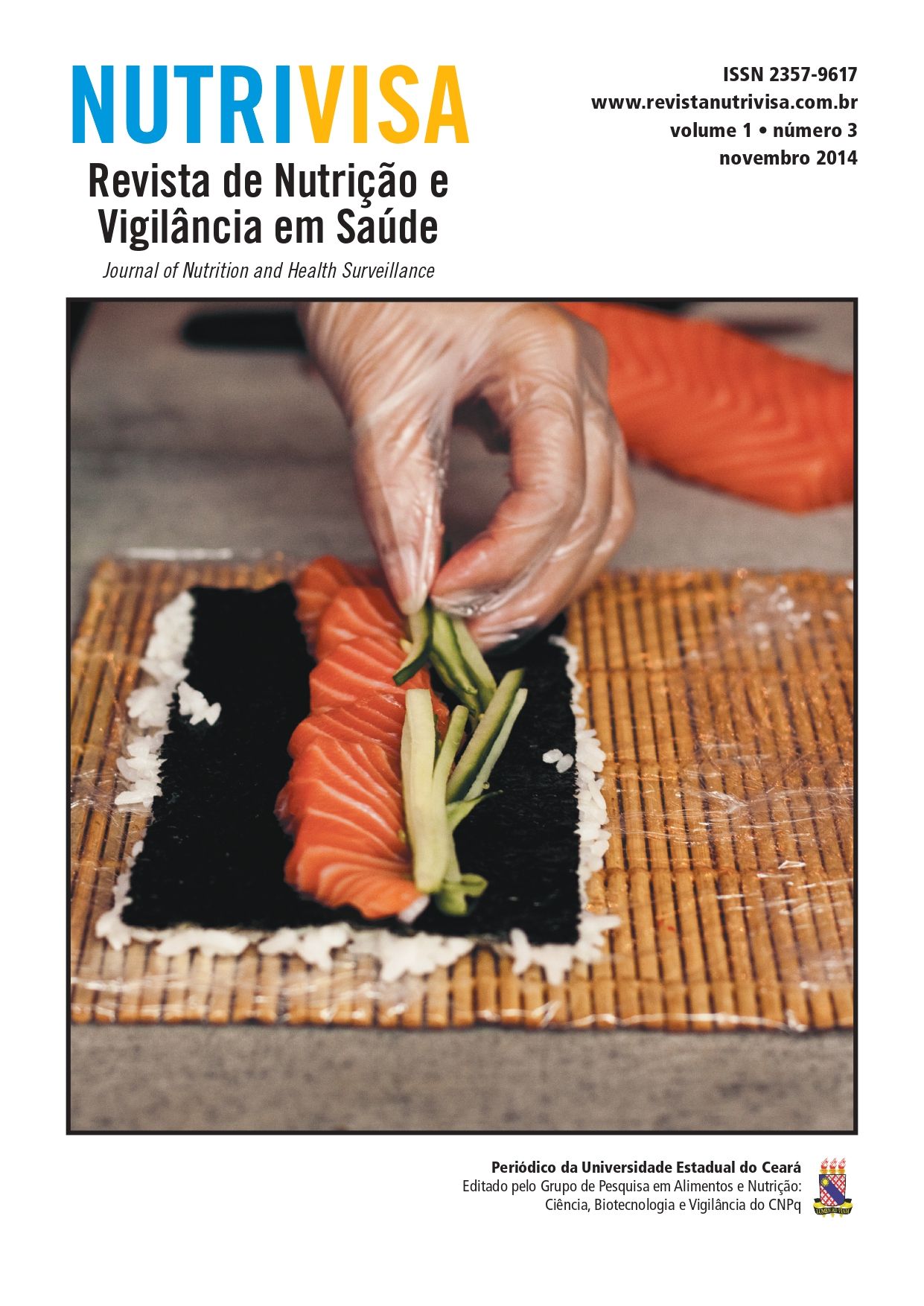Clinical applications of the use of Aloe vera and reports of toxicity
DOI:
https://doi.org/10.59171/nutrivisa-2014v1e9228Keywords:
Aloe vera, toxicity, medicinal plantsAbstract
Aloe vera is considered the most biologically active and commercialized species of the genus Aloe L. and has been used since long with therapeutic purposes, due to its anti-inflammatory and antibacterial properties of active substances that are found in concentration both in the gel as in the skin leaves. This article aimed to review the use of the Aloe vera plant with therapeutic purposes, describing clinical applications and reports of toxicity on to the non topical use of the plant, on a critical review of articles on the subject, mostly published in indexed journals in databases SCIELO, BIREME and LILACS. The various clinical applications of the Aloe vera plant, such as decreased levels of blood sugar and cholesterol, anti-inflammatory, healing agent, anticancer, antimicrobial, among many others were observed. Some research has shown some undesirable effects on the usage of the plant in large doses and depending on the form of administration. However, in acceptable doses, the numerous benefits are scientifically proven in different clinical conditions. The national organization (Anvisa) backs the use of products based on Aloe vera, both as a healing agent and as drinks’ basis. Therefore, health professionals may make rational use of these products in order to obtain the desired benefits.
References
ANVISA. Informe técnico n. 47, de 16 de novembro de 2011. Disponível em http://portal.anvisa.gov.br/wps/ wcm/connect/c66ea5804924c8f49d829f14d16287af/ Informe_Tecnico_n_47_de_16_de_novembro_de_2011. pdf?MOD=AJPERES. Acesso em: 02/03/2013.
BARADARAN, A.; NASRI, H.; NEMATBAKHSH, M.; RAFIEIAN- KOPAEI, M. Antioxidant activity and preventive effect of aqueous leaf extract of Aloe Vera on gentamicin-induced nephrotoxicity in male Wistar rats. La Clinica Terapeutica. Roma, v. 165, n. 1, p. 7-11, 2014.
BOTTENBERG, M.M.; WALL, G.C.; HARVEY, R.L.; HABIB, S. Oral Aloe vera–Induced Hepatitis. The Annals of Pharmacotherapy. Ohio, v.41, p. 1740-1743, 2007.
CARVALHO, A.C. B.; BALBINO, E.E.; MACIEL, A.; PERFEITO, J.P.S. Situação do registro de medicamentos fitoterápicos no Brasil. Revista Brasileira de Farmacognosia. Curitiba, v. 18, n. 2, p. 314-319, 2008.
CHOI, S.; CHUNG, M.H. A review on the relationship between Aloe vera components and their biologic effects. Seminars in Integrative Medicine. Washington, v. 1, n. 1, p. 53-62, 2003.
DAVIS, R.H.; DONATO, J.J.; HARTMAN, G.M.; HAAS, R.C. Anti-inflammatory and wound healing activity of a growth substance in aloevera. Journal of the American Podiatric Medical Association. v. 84, n. 2, p. 77–81, 1994.
FALEIRO, C.C.; ELIAS, S.T.H.; CAVALCANTI, L.C.; CAVALCANTI, A.S.S. O extrato das folhas de babosa, Aloe vera na cicatrização de feridas experimentais em pele de ratos, num ensaio controlado por placebo. Natureza on line. Santa Teresa, v.7, n. 2, p. 56-60, 2009.
GUPTA, A.; SETHI, J.; SOOD, S.; DAHIYA, K.; SINGH, G.; GUPTA, R. Evaluation of hypoglycemic and anti atherogenic effect of Aloe vera in diabetes mellitus. International Journal of Comprehensive Pharmacy. Singapore, v. 2, n. 8, p. 1-4, 2011.
HAMMAN, J.H. Composition and Applications of Aloe vera Leaf Gel. Molecules. Basel, v. 13, p. 1599-1616, 2008.
JOSEPH, B.; RAJ, S.J. Pharmacognostic and Phytochemical properties of Aloe vera linn –an overview. International Journal of Pharmaceutical Sciences Review and Research. Bangalore, v. 4, n. 2, p. 106-110, 2010.
KWON, K.H.; HONG, M.K.; HWANG, S.Y.; MOON, B.Y.; SHIN, S.; BAEK, J.H.; PARK, Y.H. Antimicrobial and immunomodulatory effects of Aloe vera peel extract. Journal of Medicinal Plants Research. Sapele, v. 5, n. 22, p. 5384-5392, 2011.
LANJHIYANA, S.; GARABADU, D.; AHIRWAR, D.; BIGONIYA, P.; RANA, A. C.; PATRA, K.C.; LANJHIYANA, S.K.; KARUPPAIH, M. Antihyperglycemic potential of Aloe vera gel in experimental animal model. Annals of Biological Research. Hefei, v. 2, n. 1, p. 17-31, 2011.
MAENTHAISONG, R.; CHAIYAKUNAPRUK, N.; NIRUNTRAPORN, S.; KONGKAEWA, C. The efficacy of Aloe vera used for burn wound healing: A systematic review. Burns. New York, v. 33, p. 713-718, 2007.
MANUEL, V.Y.L.L. A planta medicinal Aloe verana indústria alimentar. Portugal: Universidade Católica Portuguesa, 2011. 53p. Dissertação (Mestrado) – Escola Superior de Biotecnologia, 2011.
MINISTÉRIO DA SAÚDE. BRASIL. CONSULTORIA JURÍDICA. ADVOCACIA GERAL DA UNIÃO. Nota técnica n. 244/2013, de agosto de 2013. Brasília. p. 1-3, 2013.Disponível em: http://www.jusbrasil.com.br/diarios/37775410/trf-1-12-06- 2012-pg-182. Acesso em: 02/03/2013.
NANDAL, U.; BHARDWAJ, R.L. Aloe vera for human nutrition, health and cosmetic use - A review. International Research Journal of Plant Science. Chicago, v. 3, n. 3, p. 38-46, 2012.
OLIVEIRA, S.H.S.; SOARES, M.J.G.O.; ROCHA, P.S. Uso de cobertura com colágeno e Aloe vera no tratamento de ferida isquêmica: estudo de caso. Revista da Escola de Enfermagem. São Paulo, v. 44, n. 2, p. 346-351, 2010.
PARRA, L.A.V.; LÓPEZ, L.A.G.; RUIZ, L.A.R.; FERRER, L.J.P.; MARTÍNEZ, L.R.R. Derivados antraquinónicos del Aloe vera l. tamizaje genotóxico. Revista Cubana de Plantas Medicinales. Cidade de Habana, v. 5, n. 2, p. 46-50, 2000.
RAJASEKARAN, S.; RAVI, K.; SIVAGNANAM, K.; SUBRAMANIAN, S. Beneficial effects of Aloe vera leaf gel extract on lipid profile status in rats with streptozotocin diabetes. Clinical and Experimental Pharmacology and Physiology. Victoria, v. 33, p. 232-237, 2006.
SHAHRAKI, M.R.; MIRSHEKARI, H.; SHAHRAKI, A.R.; SHAHRAKI, E. Prevention of Aloe vera extract on Glucose, serum lipids in fructose-fed adult male rats. Iranian Journal of Diabetes and Lipid Disorders. London, p. 137-142, 2009.
SKINNER, W.L. Aloe vera injections result in Medical License Supension. Natural Medicine Law. v. 1, n. 3, p.1-8, 1997.
STURBELLE, R.T.; PINHO, D.S.; RESTANI, R.G.; OLIVEIRA, G.R.; GARCIAS, G.L.; ROTH, M.G.M. Avaliação da atividade mutagênica e antimutagênica da Aloe vera em teste de Allium cepa e teste de micronúcleo em linfócitos humanos binucleados. Revista Brasileira de Farmacognosia. Curitiba, v. 20, n. 3, p. 409-415, 2008.
USDA. Plants database. Disponível em http://plants.usda.gov/ java/ClassificationServlet?source=profile&symbol=ALOE&disp lay=31. Acesso em 02/03/2013.
VARANDA, E.A. Atividade mutagênica de plantas medicinais. Revista de Ciências Farmacêuticas Básica e Aplicada. Araraquara, v. 27, n. 1, p. 1-7, 2006.
VINSON, J.A; AL KHARRAT, H.; ANDREOLI, L. Effect of Aloe vera preparations on the human bioavailability of vitamins C and E.
Phytomedicine. Philadelphia, v. 12, p. 760-765, 2005.
VOGLER, B.K.; ERNST, E. Aloe vera: a systematic review of its clinical effectiveness. British Journal of General Practice. London, v. 49, n. 447, p. 823-828, 1999.
WILLIAMS, L.D.; BURDOCK, G.A.; SHIN, E.; KIM, S.; JO, T.H.; JONES, K.N.; MATULKA, R.A. Safety studies conducted on a proprietary high-purity aloe vera inner leaf fillet preparation, Qmatrix. Regulatory Toxicology and Pharmacology. San Diego, v. 57, n. 1, p. 90-8, 2010.
YAGI, A.; KABASH, A.; OKAMURA, N.; HARAGUCHI, H.; MOUSTAFA, S.M.; KHALIFA, T.I. Antioxidant, free radical scavenging and anti- inflammatory effects of aloesin derivatives in Aloe vera. Planta Medica. New York, v. 68, n. 11, p.957-960, 2002.
YANG, H.N.; KIM, D.J.; KIM, Y.; KIM, B.H.; SOHN, K.M.; CHOI, M.J.; CHOI, Y.H. Aloe-induced Toxic Hepatitis. Journal of Korean Medical Science. Seoul, v. 25, p. 492-495, 2010.
YIMAM, M.; BROWNELL, L.; JIA, Q. In vivo safety evaluation of UP780, a standardized composition of aloe chromone aloesin formulated with an Aloe vera inner leaf fillet. Regulatory toxicology and pharmacology: RTP, v. 69, n. 3, p. 390– 397, ago. 2014.
Downloads
Published
How to Cite
Issue
Section
License
Copyright (c) 2014 Julliete Raulino Alcântara, Alane Nogueira Bezerra, Natália Sales de Carvalho

This work is licensed under a Creative Commons Attribution 4.0 International License.














